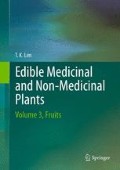Abstract
The species is native to north-central Venezuela. It is cultivated in northern South America and tropical Central America and in trial plantings in SE Asia.
Access this chapter
Tax calculation will be finalised at checkout
Purchases are for personal use only
Selected References
Ali AM, Mackeen MM, El-Sharkawy SH, Abdul Hamid J, Ismail NH, Ahmad F, Lajis MN (1996) Antiviral and cytotoxic activities of some plants used in Malaysian indigenous medicine. Pertanika J Trop Agric Sci 19(2/3):129–136
Aronow L, Kerdel-Vegas F (1965) Seleno-cystathionine, a pharmacologically active factor in the seeds of Lecythis ollaria. Nature 205:1185–1186
Burkill IH (1966) A dictionary of the economic products of the Malay Peninsula. Revised reprint. 2 volumes. Ministry of Agriculture and Co-operatives, Kuala Lumpur, Malaysia, vol 1 (A–H) pp 1–1240, vol 2 (I–Z) pp 1241–2444
Ferri T, Coccioli F, De Luca C, Callegari CV, Morabito R (2004) Distribution and speciation of selenium in Lecythis ollaria plant. Microchem J 78(2):195–203
Hammel C, Kyriakopoulos A, Behne D, Gawlik D, Brätter P (1996) Protein-bound selenium in the seeds of coco de mono (Lecythis ollaria). J Trace Elem Med Biol 10(2):96–102
Kerdel-Vegas F (1964) Generalized hair loss due to the ingestion of “coco de mono” (Lecythis ollaria). J Invest Dermatol 42:91–94
Kerdel-Vegas F (1965) The depilatory and cytotoxic action of “coco de mono” (Lecythis ollaria) and its relationship to chronic seleniosis. Econ Bot 20(2):187–195
Kerdel-Vegas F, Wagner T, Russell PG, Grant NH, Alburn HE, Clark DE, Miller JA (1965) Structure of the pharmacologically active factor in the seeds of Lecythis ollaria. Nature 205:1186–1187
Marsh TD (1937) Sapucaia nut Lecythis sp. Malayan Agric J 25:18–22
Mori SA, Prance GT (1990) Lecythidaceae—part II. The zygomorphic-flowered New World genera (Couroupita, Corythophora, Bertholletia, Couratari, Eschweilera, & Lecythis). Flora Neotrop 21(2):1–376
Müller D, Desel H (2010) Acute selenium poisoning by paradise nuts (Lecythis ollaria). Hum Exp Toxicol 29(5):431–434
Pires O’Brien J (1998) Lecythis ollaria. In: IUCN 2011. IUCN Red list of threatened species. Version 2011.1.www.iucnredlist.org
Py C, Fouqué A (1963) Les cultures fruitières de Porto Rico. Fruits d’Outre Mer 18:325–336
Author information
Authors and Affiliations
Corresponding author
Rights and permissions
Copyright information
© 2012 Springer Science+Business Media B.V.
About this chapter
Cite this chapter
Lim, T.K. (2012). Lecythis ollaria. In: Edible Medicinal And Non Medicinal Plants. Springer, Dordrecht. https://doi.org/10.1007/978-94-007-2534-8_15
Download citation
DOI: https://doi.org/10.1007/978-94-007-2534-8_15
Published:
Publisher Name: Springer, Dordrecht
Print ISBN: 978-94-007-2533-1
Online ISBN: 978-94-007-2534-8
eBook Packages: Biomedical and Life SciencesBiomedical and Life Sciences (R0)

